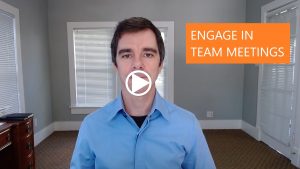
Meetings are venues to strut your stuff. When you’re not king of the castle, meetings provide you the visibility to be seen by leadership and recognized for your contributions. This is the path to promotion. But those in charge look for specific qualities. In particular, leaders seek three things when you speak up in meetings.
Focus on Data
Everyone has an opinion; therefore it should come as no surprise that leaders care about their opinions and not yours. When you present an opinion during a meeting, chances are (according to leaders I spoke with) that you will be ignored. Your place in the hierarchy puts you closer to the ground than those on top. Your value is your access to unique information – specifically the data. Divulge data you collected through your work to demonstrate your value.
Let’s say you’re a junior engineer tasked with identifying the best material to develop a new missile for the U.S. Navy. This was an example shared by a Lockheed Martin Fellow I interviewed. He said that a decent engineer will analyze the different materials and present the data in the meeting, forgoing opinions. This was a start, he said, but insufficient for promotion. Which leads us to point two –
Synthesize Conclusions
Data is information, and information is inherently meaningless. Google delivers information; so what makes you better than a search engine? Your value is translating that data into meaningful conclusions for leadership. This is where your expertise comes in: synthesize the data and explain what the data means. Explain the value of the data.
As a junior engineer at Lockheed, you identified and presented your data to colleagues on various missile materials. If you’re savvy, the next step is you will conclude, based on the data, which materials will operate best for the customer use cases. Now you’re adding tangible value. However, this is still insufficient for promotion. Which leads us to point three –
Fit to the Big Picture
Many individuals get narrow vision, optimizing just one variable amongst the many that make a successful project. Do your conclusions fit with the goals outside your domain? Have you taken into account cost factors, timing, availability, etc. These variables, although they may be secondary to your analysis, are important for real-world implementation. Explain whether your conclusions meet the needs of the project from a holistic standpoint.
At Lockheed, a junior engineer may do a fantastic job concluding which missile material will perform best under the widest set of conditions; however, if that material is prohibitively expensive, no one will purchase the product. The Technical Fellow I spoke with said that the make or break question he asks engineers after they provide their analysis is, “what’s the cost of the material?” If they don’t know the cost, it signals that they don’t see the big picture. And if they don’t see the big picture, they’re not ready to move up.
When you focus on the data, synthesize the data into meaningful conclusions, and fit your analysis to the big picture goals of the project, you gain the visibility of your superiors and demonstrate the qualities of someone worthy of leadership.


